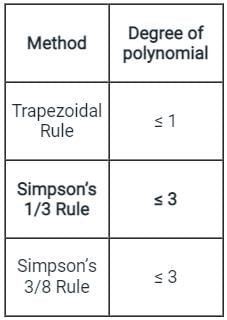Civil Engineering (CE) Exam > Civil Engineering (CE) Questions > Which order of Polynomials can best be integr...
Start Learning for Free
Which order of Polynomials can best be integrated using Trapezoidal Rules?
- a)3rd order
- b)4th order
- c)2nd order
- d)1st order
Correct answer is option 'D'. Can you explain this answer?
Most Upvoted Answer
Which order of Polynomials can best be integrated using Trapezoidal Ru...
Understanding the Trapezoidal Rule
The Trapezoidal Rule is a numerical integration technique that approximates the area under a curve by dividing it into trapezoids. Its effectiveness depends largely on the order of the polynomial being integrated.
Integration of Polynomials
- Trapezoidal Rule is particularly effective for linear (1st order) polynomials, as it assumes a straight-line approximation between two points.
Performance on Higher Order Polynomials
- 1st Order (Linear): The trapezoidal rule perfectly integrates linear functions because the area under a straight line is precisely captured by the trapezoid formed between two points.
- 2nd Order (Quadratic): While the trapezoidal rule can still provide reasonable approximations, it introduces some error due to the curvature of the parabola.
- 3rd Order (Cubic): The error increases significantly for cubic functions as the trapezoidal rule cannot adequately capture the curvature, leading to substantial inaccuracies.
- 4th Order (Quartic): Integration accuracy further deteriorates with quartic polynomials, as the trapezoidal rule fails to account for the increased complexity of the function's shape.
Conclusion
The trapezoidal rule is best suited for integrating 1st order polynomials because:
- It perfectly matches the linear function's area under the curve.
- As the order increases, the approximation errors grow due to the method's inherent limitations in capturing non-linear shapes.
Thus, the correct choice is option D (1st order), as it allows for the most accurate integration using the Trapezoidal Rule.
The Trapezoidal Rule is a numerical integration technique that approximates the area under a curve by dividing it into trapezoids. Its effectiveness depends largely on the order of the polynomial being integrated.
Integration of Polynomials
- Trapezoidal Rule is particularly effective for linear (1st order) polynomials, as it assumes a straight-line approximation between two points.
Performance on Higher Order Polynomials
- 1st Order (Linear): The trapezoidal rule perfectly integrates linear functions because the area under a straight line is precisely captured by the trapezoid formed between two points.
- 2nd Order (Quadratic): While the trapezoidal rule can still provide reasonable approximations, it introduces some error due to the curvature of the parabola.
- 3rd Order (Cubic): The error increases significantly for cubic functions as the trapezoidal rule cannot adequately capture the curvature, leading to substantial inaccuracies.
- 4th Order (Quartic): Integration accuracy further deteriorates with quartic polynomials, as the trapezoidal rule fails to account for the increased complexity of the function's shape.
Conclusion
The trapezoidal rule is best suited for integrating 1st order polynomials because:
- It perfectly matches the linear function's area under the curve.
- As the order increases, the approximation errors grow due to the method's inherent limitations in capturing non-linear shapes.
Thus, the correct choice is option D (1st order), as it allows for the most accurate integration using the Trapezoidal Rule.
Free Test
FREE
| Start Free Test |
Community Answer
Which order of Polynomials can best be integrated using Trapezoidal Ru...
The following table shows the different methods of numerical integration and degree of polynomials for which they will produce results of minimum error or zero error:

From the above table, it is clear that both Trapezoidal Rule polynomials of degree ≤ 1

From the above table, it is clear that both Trapezoidal Rule polynomials of degree ≤ 1

|
Explore Courses for Civil Engineering (CE) exam
|

|
Question Description
Which order of Polynomials can best be integrated using Trapezoidal Rules?a)3rd orderb)4th orderc)2nd orderd)1st orderCorrect answer is option 'D'. Can you explain this answer? for Civil Engineering (CE) 2025 is part of Civil Engineering (CE) preparation. The Question and answers have been prepared according to the Civil Engineering (CE) exam syllabus. Information about Which order of Polynomials can best be integrated using Trapezoidal Rules?a)3rd orderb)4th orderc)2nd orderd)1st orderCorrect answer is option 'D'. Can you explain this answer? covers all topics & solutions for Civil Engineering (CE) 2025 Exam. Find important definitions, questions, meanings, examples, exercises and tests below for Which order of Polynomials can best be integrated using Trapezoidal Rules?a)3rd orderb)4th orderc)2nd orderd)1st orderCorrect answer is option 'D'. Can you explain this answer?.
Which order of Polynomials can best be integrated using Trapezoidal Rules?a)3rd orderb)4th orderc)2nd orderd)1st orderCorrect answer is option 'D'. Can you explain this answer? for Civil Engineering (CE) 2025 is part of Civil Engineering (CE) preparation. The Question and answers have been prepared according to the Civil Engineering (CE) exam syllabus. Information about Which order of Polynomials can best be integrated using Trapezoidal Rules?a)3rd orderb)4th orderc)2nd orderd)1st orderCorrect answer is option 'D'. Can you explain this answer? covers all topics & solutions for Civil Engineering (CE) 2025 Exam. Find important definitions, questions, meanings, examples, exercises and tests below for Which order of Polynomials can best be integrated using Trapezoidal Rules?a)3rd orderb)4th orderc)2nd orderd)1st orderCorrect answer is option 'D'. Can you explain this answer?.
Solutions for Which order of Polynomials can best be integrated using Trapezoidal Rules?a)3rd orderb)4th orderc)2nd orderd)1st orderCorrect answer is option 'D'. Can you explain this answer? in English & in Hindi are available as part of our courses for Civil Engineering (CE).
Download more important topics, notes, lectures and mock test series for Civil Engineering (CE) Exam by signing up for free.
Here you can find the meaning of Which order of Polynomials can best be integrated using Trapezoidal Rules?a)3rd orderb)4th orderc)2nd orderd)1st orderCorrect answer is option 'D'. Can you explain this answer? defined & explained in the simplest way possible. Besides giving the explanation of
Which order of Polynomials can best be integrated using Trapezoidal Rules?a)3rd orderb)4th orderc)2nd orderd)1st orderCorrect answer is option 'D'. Can you explain this answer?, a detailed solution for Which order of Polynomials can best be integrated using Trapezoidal Rules?a)3rd orderb)4th orderc)2nd orderd)1st orderCorrect answer is option 'D'. Can you explain this answer? has been provided alongside types of Which order of Polynomials can best be integrated using Trapezoidal Rules?a)3rd orderb)4th orderc)2nd orderd)1st orderCorrect answer is option 'D'. Can you explain this answer? theory, EduRev gives you an
ample number of questions to practice Which order of Polynomials can best be integrated using Trapezoidal Rules?a)3rd orderb)4th orderc)2nd orderd)1st orderCorrect answer is option 'D'. Can you explain this answer? tests, examples and also practice Civil Engineering (CE) tests.

|
Explore Courses for Civil Engineering (CE) exam
|

|
Signup for Free!
Signup to see your scores go up within 7 days! Learn & Practice with 1000+ FREE Notes, Videos & Tests.


















